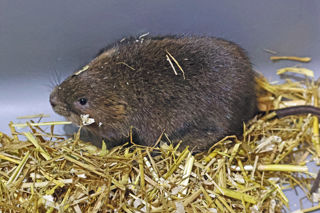
Water Vole
Arvicola amphibius
Due to their physical appearance, water voles are often misidentified as rats. On average they measure around 14-22cm in body length (tail is an additional 9-14cm) and weigh between 150-300g.
They have thick dark brown fur (often lighter on their underside), which covers their entire body including their tail (in contrast, rat tails are hairless). Another difference with rats is their shorter, blunt face and small ears.
Behaviour
Semi aquatic, diurnal rodent. Water voles excavate burrow systems within the banks of the wetlands they live alongside, which have separate nesting chambers at different levels, including underwater entrances.
Feeding stations can often be used as reliable field signs; food is brought to “favourite” feed stations, and normally comprise of a neat pile of chewed vegetation with a 45 degree. Males have larger ranges than females, often marked with faecal latrines (which can be used as an indicator of species presence for surveying). Latrines are areas where water voles deposit droppings, often flattening them with their hind feet. These locations act as a method of communication between individuals by providing information on their breeding condition.
UK Status
Once common and widespread in the UK, this distribution has become severely reduced and are completely absent from Ireland, Isle of Man, and the Scottish Islands. It is estimated Water voles have declined by 90-95% since the 1960s, once lending it the title of the UK’s fastest declining mammal.
They are fully protected under the Wildlife and Countryside Act of 1981, making disturbance, damage or obstruction to them or their breeding places a criminal offence. They are also a UK BAP species.
Threats
Habitat loss and degradation are major threats, these are then intensified by predation from the introduced American mink. It is widely accepted that predation from non-native mink is the cause of decline of water voles in the UK.
Water pollution has also been argued to a contributing factor to their dramatic decline; contaminants such as insecticides and other farm waste chemicals.

Distribution
Large range within Europe, from the UK in the west, to Lake Baikal in Siberian Russia in the east. It can be found as far north as the Arctic Circle, and as far south as Iran.
Habitat
Freshwater rivers, ditches, lakes and wetlands with lush riparian vegetation from banks and the water. They prefer slow flowing, deep water as well as soft, silty banks in order to easily burrow into.
Diet
Herbivorous. Aquatic grasses and other vegetation found on the water’s edge are readily eaten (227 plant species have been identified as part of their diet so far).
Wildwood inside information
The work Wildwood does when it comes to water voles is extensive; covering captive breeding, mitigation services for developers, equipment hire, reintroductions and handling training courses. For more information regarding our water vole projects, please see our conservation page.
Family facts
The much loved character from The Wind in the Willows, ironically named “Ratty” was actually a water vole.
Water voles eat up to 80% of their own body weight each day.
-
![Water Vole]()
Wildwood animal adoptions last for one year and are the perfect gift for any animal lover. Each adoption helps support our work to save British wildlife. We have different levels of adoption available to suit all occasions and budgets.
ADOPT ME!
-
![Water Vole 1200X1200]()
Wildwood offers a range of water vole services from assisting ecological consultants with mitigation strategies to full reintroductions. Any profit generated through our ecological services is invested back into our conservation projects.
Read me!


